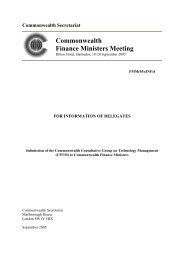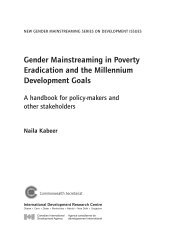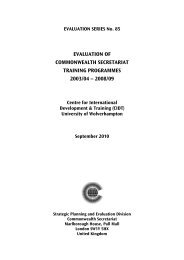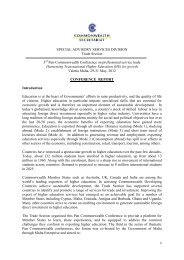Gender Mainstreaming in HIV/AIDS - Commonwealth Secretariat
Gender Mainstreaming in HIV/AIDS - Commonwealth Secretariat
Gender Mainstreaming in HIV/AIDS - Commonwealth Secretariat
You also want an ePaper? Increase the reach of your titles
YUMPU automatically turns print PDFs into web optimized ePapers that Google loves.
GENDER MAINST R E A M I NG IN <strong>HIV</strong>/<strong>AIDS</strong>: TA K I NG A MULT I S E C TORAL APPROACH<br />
play a central role <strong>in</strong> <strong>AIDS</strong> prevention and care programmes,<br />
and strategies need to be developed that utilise their energies<br />
and expertise.<br />
S<strong>in</strong>ce <strong>HIV</strong>/<strong>AIDS</strong> is not just a health issue but is affected by<br />
and impacts on every aspect of life, it is vital that it is met by<br />
a multisectoral response. This response must be dynamic and<br />
react to the epidemic as it evolves. It calls for strong and creative<br />
leadership, <strong>in</strong>clud<strong>in</strong>g political will at the highest level.<br />
Governments must take the lead <strong>in</strong> foster<strong>in</strong>g a supportive<br />
environment and provid<strong>in</strong>g a framework for action that works<br />
both horizontally (with government, bus<strong>in</strong>ess and civil society<br />
o rganisations) and vertically (at <strong>in</strong>ternational, national and<br />
community levels).<br />
Every level of society should be <strong>in</strong>volved, and partnerships<br />
need to be developed between m<strong>in</strong>istries responsible for different<br />
sectors, and between them and the private sector, civil<br />
society organisations, communities and people liv<strong>in</strong>g with <strong>HIV</strong>/<br />
A I D S . Different partners br<strong>in</strong>g different strengths and experiences<br />
of partnership development, and best practice <strong>in</strong> multisectoral<br />
responses need to be shared.<br />
S<strong>in</strong>ce the pattern of <strong>HIV</strong> transmission and the stage of the<br />
epidemic are different <strong>in</strong> each country, depend<strong>in</strong>g on the<br />
underly<strong>in</strong>g social, economic, political and cultural context, a<br />
consensus needs to be reached of what needs to be done <strong>in</strong> that<br />
particular country. In prepar<strong>in</strong>g culturally-appropriate national<br />
<strong>HIV</strong>/<strong>AIDS</strong> policy guidel<strong>in</strong>es, case studies, tools and resources,<br />
government analysts and decision-makers need to factor <strong>in</strong><br />
gender <strong>in</strong>dicators. The <strong>Gender</strong> Management System is flexible<br />
enough to be adapted to the issue of <strong>HIV</strong>/<strong>AIDS</strong> and to the dist<strong>in</strong>ctive<br />
national context.<br />
<strong>Ma<strong>in</strong>stream<strong>in</strong>g</strong> gender calls for skills <strong>in</strong> gender analysis<br />
and plann<strong>in</strong>g; the capacity to collect and <strong>in</strong>terpret sexdisaggregated<br />
data; a commitment by government to action to<br />
achieve gender equality; and the availability of human, technical<br />
and f<strong>in</strong>ancial resources. Both short- and long-term<br />
gender-sensitive strategies need to be developed from the community<br />
to the national level. Short-term strategies might focus<br />
on people’s immediate needs, such as <strong>in</strong>formation, support to<br />
home-based care and access to treatment for STIs. More longterm<br />
strategies need to address the underly<strong>in</strong>g social and<br />
cultural structures that susta<strong>in</strong> gender <strong>in</strong>equality.<br />
In all areas, programmes have to deal with issues of economic<br />
power imbalances, migrations, economic and social marg<strong>in</strong>alisation,<br />
development of community responses, participation<br />
and capacity build<strong>in</strong>g for susta<strong>in</strong>ability. It should be recognised<br />
that education has a key role to play as a means of<br />
impart<strong>in</strong>g the knowledge and skills essential for <strong>in</strong>dividual,<br />
communal and national survival. Any successful response will<br />
<strong>in</strong>tegrate prevention and care. It is not enough to focus on<br />
<strong>in</strong>dividual behaviour change because poor health, gender,<br />
poverty and other factors also play an important role <strong>in</strong> vulnerability<br />
and susceptibility to <strong>HIV</strong>. The poorest and most vulnerable<br />
groups, <strong>in</strong>clud<strong>in</strong>g women and young people, need to be<br />
seen as resources and not just victims.<br />
Each sector must plan and make available resources for an<br />
<strong>in</strong>tegrated response, <strong>in</strong>clud<strong>in</strong>g an analysis of the factors with<strong>in</strong><br />
the sector that contribute to the spread of <strong>HIV</strong>/<strong>AIDS</strong>, the<br />
impact of the disease on its workforce and products, and the<br />
consequences for both the sector and the community. Practical<br />
short-term and long-term <strong>in</strong>terventions need to be developed<br />
to protect the sector’s workers, to cope with the skills shortages<br />
that will arise and to mitigate the adverse effects on society.<br />
In agricultur e, for example, it is likely that the <strong>AIDS</strong> epidemic<br />
will cause a major labour shortage <strong>in</strong> many countries. If<br />
a family member is sick with <strong>AIDS</strong>, it will usually be a woman<br />
who cares for them, mean<strong>in</strong>g she may be unable to carry out<br />
her usual agricultural tasks. This <strong>in</strong> turn may result <strong>in</strong> chronic<br />
f o od <strong>in</strong>security as well as high levels of malnutrition and micronutrient<br />
deficiencies. Girls may also be kept out of school to<br />
care for the sick or help with household tasks.<br />
In addition, the deaths of farmers, extension workers and<br />
teachers from <strong>AIDS</strong> can underm<strong>in</strong>e the transmission of knowledge<br />
and know-how as well as the local capacity to absorb<br />
t e c h n ology transfers. Widows may be left without access to<br />
productive resources such as land, credit and technology and<br />
their livelihoods may be threatened. <strong>HIV</strong>/<strong>AIDS</strong> also leads to a<br />
reduction <strong>in</strong> <strong>in</strong>vestment <strong>in</strong> irrigation, soil enhancement and<br />
other capital improvements.<br />
<strong>HIV</strong>/<strong>AIDS</strong> not only affects education through the loss of<br />
EXECUTIVE SUMMARY<br />
xiv xv














